Coupled with the national food security strategy, Transforming the Manufacturing industry of yeast protein as the most advantageous sustainable alternative protein into a demonstration project for developing new quality productive forces
Summary
It is of great significance for the national food security strategy to that Transforming the Manufacturing industry of yeast protein,which is as the most advantageous sustainable alternative protein,into a demonstration project .
Developing new quality productive forces, relying on technological innovations, breaking through technical bottlenecks such as the construction of yeast strains with high protein content and rich human nutrients, low-cost, efficient and environmentally friendly saccharification from biomass, efficient and low-energy bacterial crushing, and efficient recovery and preparation of yeast protein, and achieving the ultimate goal of industrialization and commercial operation of this demonstration project.
At the same time, in view of the unique biological characteristics of yeast protein with relatively low L-methionine content and rich folic acid content, according to the latest series of scientific research results (July 26, 2024, Nature Aging magazine titled "Separation of reproductive decline from lifespan extension during methionine restriction". New dietary plan: limit L-methionine to increase compensation for folic acid to prolong life and improve fertility), yeast protein can be labeled as" nutritious and life extending food ", develop a series of high value-added, unique products in the field of health, and further promote the rapid and healthy development of the yeast protein industry.
The industrialization and commercial operation of the yeast protein project will further enrich the variety and quality of food, effectively compensate for the shortage of animal protein and plant protein resources, and have important significance for enhancing China's comprehensive self-sufficiency in protein food and ensuring national food security.
Catalog
I. The importance of food security and responses to future challenges
II. History of single-cell proteins and yeast proteins as alternative proteins
III. The development of new quality productive forces leads the process of yeast protein industrialization
Ⅳ. The yeast protein industry has the basic conditions for the development of new quality productive forces demonstration projectsⅤ. Guided by the idea of developing new quality productive forces, we will break through the technical bottleneck of over 10,000-ton scale production in the yeast protein industryⅥ. Achieve the goal of industrialization of low-cost and environmentally friendly yeast protein, and resolve the potential threat of United States and other countries strategically restricting soybean exports, resulting in the restriction of meat food production in China
Ⅶ. Yeast protein products are used in the big health industry
Ⅷ. Conclusion
I. The importance of food security and responses to future challenges
As a large country with a population of 1.4 billion, China's national food security is of paramount importance. Food security has constantly been a major strategic issue that concerns the overall development of China's national economy, social stability, and national independence.
Currently, China has basically achieved self-sufficiency in grain production. The Challenge for China's food security is the issue of over 300 million tons of feed grain, especially the need to import over 100 million tons of soybeans annually, mainly used as feed protein to produce the food protein needed by the public, namely meat protein food.
How to deal with the challenge of the relative shortage of meat food in China? It is necessary to base ourselves on the domestic market and rely on the development of new quality productive forces, scientific and technological innovation and industrial innovation to ensure national food security at the source.
To support national food security, it is necessary to accelerate the substitution of new protein resources and to build future food research and development. As scientific and technological personnel in the new era, we must promote and inherit the spirit of "two bombs and one satellite", become the main force in developing new quality productive forces practices, combine the direction of scientific research with national strategic requirements, dare to pursue the ultimate, work hard, and complete the new alternative protein - yeast protein as the ultimate alternative protein.
II. History of single-cell proteins and yeast proteins as alternative proteins
According to Internet data, China's pork, beef, mutton and poultry meat output will be 96.41 million tons in 2023. Among these, pork production was 57.94 million tons, beef production was 7.53 million tons, poultry production was 25.63 million tons, and poultry egg production was 35.63 million tons.
According to the composition analysis of meat protein(Fig.1), the average protein content of pork is about 13.2%, the average protein content of beef is 20%, and the protein content per 100 grams of chicken breast is about 19.4g. An egg contains approximately 12% protein. From this, it can be concluded that the pure protein content of pork, beef, poultry, and poultry eggs is 7.65 million tons, 1.5 million tons, 4.61 million tons, and 4.27 million tons, respectively. The total protein content of meat, poultry, and eggs is approximately 18.03 million tons.

Figure 1: Comparison of protein content of major foods (percentage content). Yeast protein (calculated by dry weight) content is the highest.
The shortage of meat protein in China is still severe, and the self-sufficiency rate of high-quality protein is insufficient. The rise and development of alternative proteins will alleviate the conundrums how meat protein (animal protein) is produced.
Alternative protein refers to foods or products that are used to replace traditional animal protein, provide similar nutritional value and taste to animal protein, and have the characteristics of sustainability and environmental protection. Alternative proteins mainly include single-cell proteins, plant proteins, insect proteins, cell culture proteins, etc.
Single-cell proteins, proteins extracted from single-celled microorganisms. The most important single-cell proteins are yeast proteins, bacterial proteins, and algal proteins, which are generally dominated by proteins and fats in their chemical composition.
Yeast protein is an ideal source of food-grade protein due to its high production efficiency, environmental friendliness, high nutritional value and health benefits, and will play an important role in the production of alternative proteins in the future.
During the First World War, Germany first used acid hydrolyzed wood to prepare saccharified liquids and raw yeast single-cell proteins. The former Soviet Union produced more than one million tons of single-cell protein annually.
The development of single-cell proteins was the beginning of true biotechnology, and later thanks to the development of agricultural technology, the use of chemical fertilizers and pesticides greatly increased yields. The cost of producing single-cell proteins is no longer competitive with proteins such as soy and fishmeal.
In the past 10 years, biotechnology has undergone fundamental changes, with the continuous progress and improvement of biotechnology represented by genetic engineering, protein engineering and gene editing technology, and the fermentation industry and enzyme preparation industry have entered a new period of development. The application of biotechnology integrated research results, the industrial production of low-cost nutritional yeast protein technology has become more and more mature.
III. The development of new quality productive forces leads the process of yeast protein industrialization
Innovation is the first driving force for development. The development of new quality productive forces needs to start from these aspects, including strengthening scientific and technological innovation, promoting the research and development and promotion of new technologies, new processes, and new products, and improving the technological level and competitiveness of the industry.
Combined with examples, the specific characteristics of yeast protein industry as an example of developing new quality production are analyzed.
1. Product innovation. Food-grade full nutritional yeast protein (referred to as yeast protein) responds to the strategic needs of China's relatively insufficient supply of meat food, as well as to meet the demand for human nutrition and market replacement protein.
From a nutritional point of view, yeast protein contains 20 amino acids required by the human body, including 8 essential amino acids (Figure 2). Lysine is the first limiting amino acid in plant protein (wheat/cereal) and is abundant in yeast protein. Branched-chain amino acids (isoleucine, leucine, and valine), which are currently emphasized in nutrition, also account for a high proportion of yeast proteins.
Yeast protein is unique in terms of its amino acid composition and vitamin richness: relatively low levels of L-methionine (Figure 2) and high levels of folic acid (the highest folic acid content of any food). According to the latest medical research results: new dietary regimen: limiting L-methionine to increase the compensation of folic acid to prolong life and improve fertility. Yeast protein can be labeled as "nutritious and life-enhancing food", develop a series of high value-added products in the field of health, and further promote the rapid and healthy development of yeast protein industry.
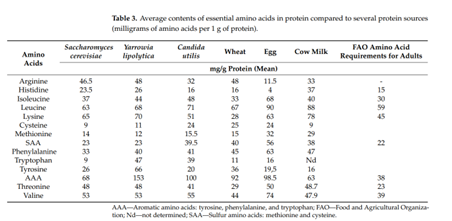
Figure 2: Comparison of amino acid composition of proteins from several sources, including yeast protein.
According to the nutritional characteristics of yeast protein, the product involved in this demonstration project, aiming at the most popular medical research results, namely "the starting point of disease is mitochondrial dysfunction" and "the end point of disease research is mitochondria", it is applied to the clinical treatment field of mitochondrial regeneration and energy supply improvement, including neurodegenerative diseases ( Alzheimer’s disease and Parkinson's syndrome), cancer, diabetes, cardiovascular diseases, etc.
The research on the cell metabolism of tissues and organs of diabetes, neurodegenerative diseases (Alzheimer's disease and Parkinson's syndrome), cancer, cardiovascular diseases and other diseases showed that the disorder of mitochondrial metabolism in cells was widespread, especially the impairment of pyruvate dehydrogenase system function, which was an important link in the pathological mechanism of diabetes. This functional impairment not only affects energy metabolism, but is also associated with various pathological processes such as oxidative stress and inflammatory response. Therefore, in-depth research and understanding of this mechanism are of great significance for developing new therapeutic targets and strategies.
2. Innovation in production processes. The application of mechanical disruption for microbial cells combined with biological enzyme based nucleic acid removal technology in the new production process of yeast protein results in yeast protein products that maintain non enzymatic degradability, hence the name yeast nutritional protein. The production process is simplified as high-density fermentation yeast —> yeast collection —> directed specific enzyme method combined with mechanical rupture —> external biological enzyme method for nucleic acid remova—> centrifugal combined with industrial membrane separation and purification process —> obtaining four products, namely cell wall polysaccharides, yeast protein, nucleic acid and nucleotides, and nutrient rich human cell mitochondrial nutrient products.
The current common process for producing yeast protein is to collect yeast cells and use the autolysis method to break the cell wall and self-enzymatic hydrolysis to reduce nucleic acid (with the addition of partial nucleases) to produce yeast protein.
3、Application and marketing innovation. Based on the composition of yeast cells, the following four categories of products are produced to further improve the economy of yeast protein series products:
a. Food grade yeast protein products, with protein content controlled between 50-85%.
b. Cell wall polysaccharide products, including β - glucose and mannan.
c. As a nutritional component of cellular mitochondria, it is a food grade yeast extract rich in various coenzyme components and B group mitochondrial nutrients, particularly rich in vitamin B12 and folic acid. B12 vitamin is generally not present in plant-based foods, and it can be used in the field of mitochondrial targeted nutrition to reverse aging and promote overall health.
Aging is often accompanied by gradual loss of cellular function and systemic deterioration of multiple tissues, leading to functional impairment and a tendency towards death. Mitochondria are not only considered as energy providers, but also play a vital role in aging related diseases, such as neurodegenerative diseases, diabetes, and cardiovascular diseases. More and more evidence suggest that aging is closely related to energy supply-demand imbalance, which can be alleviated through various intervention measures. The market potential for targeted mitochondrial therapy and nutritional intervention is enormous.
Ⅳ.The yeast protein industry has the basic conditions for the development of new quality productive forces demonstration projects
The core essence of developing new quality productive forces lies in achieving qualitative changes in labor materials, laborers, and their optimized combinations through revolutionary technological breakthroughs, innovative allocation of production factors, and deep transformation and upgrading of industries, as well as improving total factor productivity.
Developing new quality productive forces and cultivating new industries are key tasks. Strategic emerging industries are the key to building a modern industrial system and the main battlefield for developing new quality productive forces.
Yeast protein is a pure natural and almost perfectly balanced nutritional food, making it an ideal source of nutrition. Yeast protein has the characteristics of "three lows and four excellences", namely low fat, low sugar, low cholesterol, containing high-quality protein (including all essential amino acids), nutritional factors and coenzymes required by the "mitochondria" of human cellular energy plant, various rare mineral elements, and high-quality dietary fiber. Yeast protein is a high-quality protein with high bioavailability, which can be used as a new alternative protein for food grade applications.
The first challenge in developing food grade yeast protein products is high nucleic acid (purine) content (Table 1). Excessive levels of nucleic acid (up to 15%, percentage content) from yeast protein can cause diseases such as gout, metabolic imbalance, and urinary stone positivity. Overcoming the limitations of high nucleic acid content and high cost, improving the functional characteristics and sensory acceptability of yeast protein will greatly promote its market application. The safety standard for nucleic acid in general food is 1-2%.

Table1: The contents of main components in different microorganisms
The main methods for industrial production of nucleic acid removal are alkaline and enzymatic methods, but both have technical shortcomings. The alkaline process leads to the loss of protein nutrients and the production of lysine-alanine dipeptide byproducts that are toxic to the kidneys. The enzymatic method cannot be further promoted and used due to the expensive enzyme preparations used.
One of the core technologies of this demonstration project is the low-cost preparation of specific enzyme preparations for enzymatic nucleic acid removal. In the past 10 years, there have been fundamental changes in production technology, and the continuous progress and improvement of molecular biology technologies represented by genetic engineering and protein engineering have brought the enzyme preparation industry into a new period of development.
By integrating research results from biotechnology, we have completed the industrial and low-cost production of high activity nuclease composite preparations, which have been applied in the production process of yeast protein nucleic acid removal:
1. We have reduced the ribonucleic acid content of yeast protein extract from 6-8% to 0.6-1.0% (Figure 3), fully achieving food grade safety levels. After efficient removal of nucleic acid and easier physical recovery of yeast protein, the recovery rate is increased by 5-10%, further improving the economic efficiency of yeast protein.
2. The yeast protein produced is called total nutritional yeast protein. Due to the use of direct mechanical disruption of yeast cell to further obtain protein and other nutrients, various proteins and nutrients are not subjected to enzymatic hydrolysis by proteases, maintaining their natural biological activity and structural integrity (Figure 4).
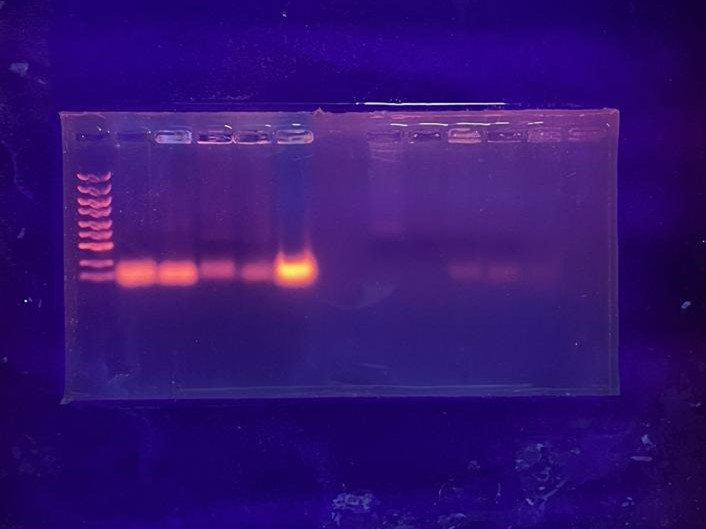
Figure 3: Nucleic acid electrophoresis analysis of a series of yeast-related products - visual comparison of nucleic acid content of various samples.
From left to right (loading): 1: nucleic acid standard molecular weight; 2: Imported yeast extract (sample 2, Yeast Extract); 3: A commercial yeast protein (sample 3); 4: A commercial yeast extract (sample 4); 5) Ying's pork liver powder (sample 5); 6: The yeast protein sample obtained by drying directly after the dry yeast is broken (sample 6); 7: Not loaded; 8: Enzymatic hydrolysis of supernatant of dry yeast crushing solution; 9: enzymatic digestion buffer; 10,11: Yeast protein samples (made by the R&D team involved in this demonstration project) were obtained by direct mechanical disruption combined with nuclease enzymatic nucleic acid reduction (Samples 10,11). The sample loading volume was 20ul, and the sample concentration was 20g/L. Intuitive comparison of nucleic acid concentrations of samples: The nucleic acid content of Ying's pig liver powder was used as the reference standard to compare the relative concentrations of nucleic acids. Samples 2,3 are 3 times larger than the reference standard; Sample 4 is comparable to the reference standard sample; Sample 6 is 8-10 times that of the reference standard sample; Samples 10,11 (the new yeast protein covered herein) are 1/3 times larger than the reference standard.
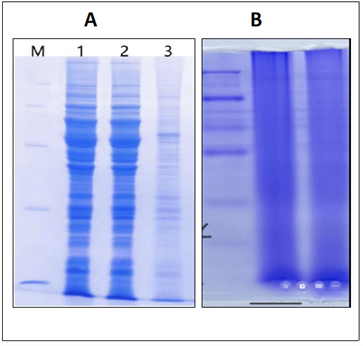
Figure 4: SDS-PAGE analysis of yeast protein (A, made by the R&D team involved in this demonstration project) and commercially available yeast protein products (B) involved in this article.
The second challenge for yeast protein to become the ultimate alternative protein is the low utilization rate of cell wall digestion. Yeast protein needs to be converted into grain protein and feed protein by solving the problem of difficult digestion of cell walls and breaking down yeast to obtain protein for utilization. The cell wall of brewing yeast accounts for 20% to 30% of the dry weight of the cells, and the polysaccharide components composed of β - glucan and mannan account for about 77% of the yeast cell wall components. This type of polysaccharide exhibits strong resistance to digestion and is not easily digested, absorbed, or utilized by humans or animals. By utilizing directional composite enzymes capable of hydrolyzing the two types of polysaccharides mentioned above, the polysaccharide cell wall can be selectively hydrolyzed. Combined with mechanical disruption technology, a new industrial disruption process can be established, which has a high yield of yeast protein and can overcome the technical shortcomings of using autolysis disruption method to decompose and destroy proteins and small molecule nutrients inside yeast cells.
Ⅴ.Guided by the idea of developing new quality productive forces, we will break through the technical bottleneck of over 10,000-ton scale production in the yeast protein industry
1. Solving the problem of raw material sources for producing yeast protein in two steps
First step: Using starch sugar or molasses as the main fermentation material, the entire production process is connected to prepare qualified products. According to current production technology, 6 tons of starch sugar or 10 tons of molasses are required to produce 1 ton of yeast protein (with a protein content of 80-90%).
The main raw materials for producing yeast protein come from molasses or glucose. According to the current yeast production technology, the production cost per ton of yeast protein (with a content of over 80%) is 40000-45000 RMB (Chinese Yuan). This production cost is already lower than the production cost of chicken (which is the highest meat/feed ratio meat production method and the cheapest meat).
The second step: It is necessary to follow the principle of "not competing with grain for land, not competing with people for grain" to completely solve the problem of the source of raw materials for the production of yeast protein. The annual output of crop straw is about 900 million tons, and there are also a large number of non-food biomass such as 32 million tons of distiller's grains and 12 million tons of rice bran. If it is used as a carbon source, food-grade and feed-grade protein can be efficiently synthesized under the biotransformation of microorganisms, so as to develop a food protein manufacturing route in line with China's national conditions. That is, it can solve the " stranglehold" problem of the shortage of feed protein in China, and also solve the ecological and environmental problems caused by China's waste biomass, and the protein products produced by non-grain will become the largest product in China's biological manufacturing.
In 2023, the production of pigs, cows, sheep, and poultry meat in China was 96.41 million tons. According to its average protein content, the total protein content is approximately 18.03 million tons.
Consuming 200 million tons (China's total amount reaches 900 million tons) of crop straw, more than 100 million tons of straw sugar (derived from cellulose sugars and hemicellulose sugars)can be prepared, producing 30 million tons of dry yeast and 15 million tons of yeast protein, which is close to the level of 18.03 million tons of total protein in meat food.
Lignocellular biomass (LCB), including crop straw, is the most abundant renewable carbon resource on Earth, mainly composed of cellulose (35-50%), hemicellulose (20-35%), and lignin (10-25%). The production process of yeast protein using LCB as a fermentation raw material includes: LCB pretreatment (removal of lignin, retention of cellulose and hemicellulose) —> cellulose and hemicellulose hydrolysis to prepare fermentation sugar —>yeast fermentation —>preparation of yeast protein.
LCB low-cost environmentally friendly pretreatment and efficient enzymatic sugar production are key technologies for producing starch sugar (fermented sugar) by replacing corn and other grain crops with lignocellulose. They are the fundamental guarantee for achieving the strategic goal of producing alternative proteins without competing with humans for food or land. According to the current price level, the cost of straw sugar preparation is controlled at 3500-4000 RMB(CN yuan)/ton.
Physical, chemical, physicochemical, and biological process pretreatment methods have been widely used for the conversion of LCB into biofuels and value-added biological compounds. Effective and economically feasible LCB pretreatment methods mainly depend on:
a. low energy consumption.
b. Low cost.
c. Environmentally friendly refers to the effective treatment and regeneration of wastewater and solid waste.
d. Efficient.
The new green LCB pretreatment technology has shown promising and convincing results. Pretreatment with new green solvent based ionic liquids (IL) and deep eutectic solvents (DES). DES solvent is a promising alternative to IL due to its non-toxic, low-cost, environmentally friendly, low volatility, biodegradability, enzyme compatibility, and other advantages, demonstrating effective biotransformation of LCB at the laboratory scale. The recycling and reusability of DES can also improve the economic and technical efficiency of LCB pretreatment technology.
Breaking through IL or DES, or other pretreatment synchronized cellulase hydrolysis lignocellular biomass technology, is currently a hot and difficult topic and key point in the field of lignocellular biomass conversion. This is also the difficulty that lignocellular biomass has not truly become a feasible alternative to starch for preparing fermented sugars. The technical advantages of lignocellulose in the simultaneous enzymatic hydrolysis and sugar production process with IL or DES pretreatment are: 1. Cellulose and hemicellulose are in a dissolved state and are easily degraded into monosaccharides by enzymes. 2. Avoiding the problem of contaminating bacteria during the enzymatic hydrolysis process (which is long and difficult to achieve aseptic state). 3. Low concentrations of fermentation inhibitors or other toxic substances generated during the pretreatment process are beneficial for the next fermentation production section. Although there are not many reports on the research of one pot method for simultaneous pretreatment and enzymatic sugar production, there have been research groups conducting related studies (One Pot Ionic Liquid Mediated Bioprocess for Pretreatment and Enzymatic Hydrolysis of Rice Straw with Ionic Liquid -Tolerance Bacterial Cellulase, 2022).
2. Overcoming low-energy and high-efficiency yeast wall disruption technology
The composition of yeast cell wall is complex, mainly composed of pectin, mannose, and protein, which interweave into a complex network structure. Industrial scale disruption of yeast cell wall is a challenging task.
To obtain protein resources within yeast cells, an efficient wall disruption method is first required. Yeast cell wall disruption is the process of breaking down the yeast cell wall and releasing the nutrients inside and protein. Common yeast wall disruption methods include enzymatic method, ultrasonic method, high-pressure homogenization method, and autolysis method.
At present, the industrial production of yeast extracts mainly adopts autolysis method, which utilizes yeast to undergo autolysis under the action of its own hydrolytic enzymes (protease, nuclease, sugar hydrolase, etc.) to release its contents. The autolysis method is simple and easy to operate. Shortboard refers to the degradation of yeast protein into peptides to varying degrees, resulting in low recovery rates. The degradation of antioxidants polyphenols and glutathione is more severe.
From the perspective of the current development of industrial disruption technology of yeast cells, the combination of directed enzymatic wall lysis and high-pressure homogenization method, or directional enzymatic wall lysis and mechanical ball milling method (Fig. 5) is the priority development process for low-energy industrial sterilization. Direct mechanical disruption in one step, such as high-pressure homogenization method (using the largest homogenization equipment, with a wet weight of 20%, a sample volume of 1 cubic meter per hour, a pressure of 1000 bar, and homogenization twice). Crushing yeast to prepare 1 ton of yeast protein requires up to 5,000 kWh. If tens of thousands of tons are required, energy consumption and equipment investment are huge.
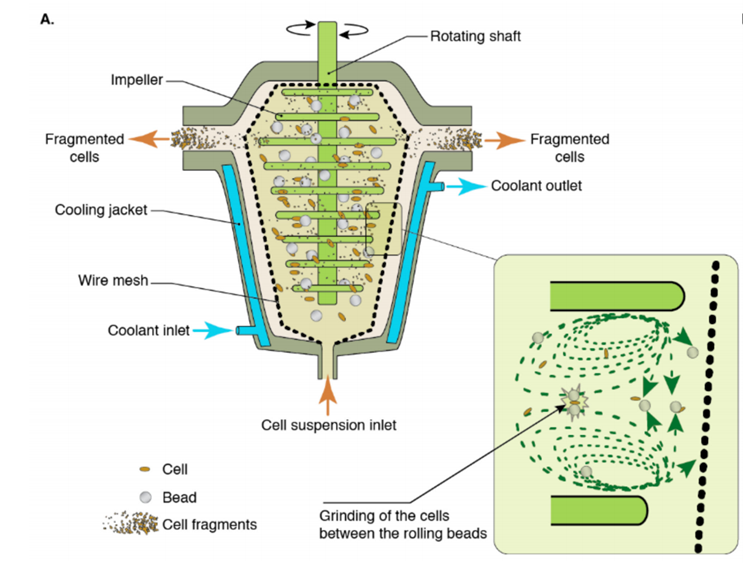
Figure 5: Principle of yeast mechanical ball milling fragmentation. Taken from: Mechanical Cell Disruption Technologies for the Extraction of Dyes and Pigments from Microorganisms
3. Application of Enzyme based Nucleic Acid Reduction Technology
Excessive levels of yeast protein nucleic acid(up to 15%) can cause diseases such as gout, metabolic imbalance, and urinary stone positivity. Overcoming the limitations of high nucleic acid content and high cost, improving the functional characteristics and sensory acceptability of yeast protein will greatly promote its market application.
The main methods for reducing nucleic acid in industrial production are alkaline and enzymatic methods, but both have technical shortcomings. The alkaline process leads to the loss of protein nutrients and the production of lysine-alanine dipeptide byproducts that are toxic to the kidneys. The current enzymatic process for reducing nucleic acid efficiency and degree has not reached the predetermined target. Due to the expensive enzyme preparations used, it is difficult to further promote their use.
One of the core technologies unique to the demonstration project is the low-cost preparation of highly efficient enzyme preparations for nucleic acid reduction using the aforementioned enzymatic method. In the past 10 years, there have been fundamental changes in production technology, and the continuous progress and improvement of molecular biology technologies represented by genetic engineering and protein engineering have brought the enzyme preparation industry into a new period of development.
This demonstration project applies the research results of biotechnology integration to complete the industrial and low-cost production of high activity nuclease composite preparations, which are applied in the production process of yeast protein nucleic acid removal. The ribonucleic acid content of yeast protein extract is reduced from 6-8% to 0.6-1.0% (Figure 6), fully reaching the food grade safety level. After efficient nucleic acid reduction and easier physical recovery of yeast protein, the recovery rate is increased by 5-10%, further improving the economic efficiency of yeast protein.
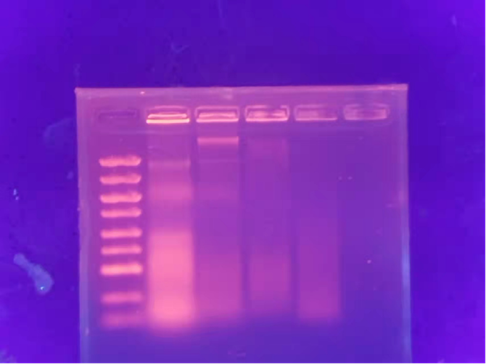
Figure 6: Analysis of Nucleic Acid Degradation by Specific Enzymes in Yeast Protein by Electrophoresis
Annotation: 1. DNA standard molecular weight. 2. Yeast protein(YP) was not treated with enzymes. 3.YP was treated by Enzyme 1 treatment. 4. YP was treated by Enzyme 2 treatment. 5. YP was treated by Enzyme 3 treatment. 6. YP was treated by Enzyme 4 treatment. From left to right is 1 to 6. It can be intuitively seen that about 2/3 of the DNA in the 6th lane sample has been removed, and RNA is basically invisible. Through quantitative analysis, the nucleic acid content of YP obtained from related R&D products has reached the food grade safety standard.
4. This demonstration project has spurred the emergence of new technologies, devices, and processes
a. Low cost and efficient production technology for enzyme preparations
This demonstration project involves the use of cellulase and hemicellulase to obtain fermentable sugars from lignocellulose, requiring low-cost and efficient enzyme preparation technology.
The enzyme preparation industry is now a high-tech industry with high added value, maintaining sustained and rapid development. The application of enzyme preparations covers many industries such as washing, textile, tanning, feed, paper and food, creating hundreds of billions of yuan of industrial added value every year.
At present, the global industrial enzyme industry market presents an oligopoly situation. Market resources are highly concentrated, with Novozymes and DuPont in Europe and the United States accounting for about 70% of the market share.
With the continuous development of advanced biotechnology such as high-throughput screening, protein structure elucidation, bioinformatics, and genome editing, the industrialization process of high-performance and low-cost enzyme preparations is accelerating. From the design and transformation of enzymes, to the efficient expression of enzymes, to the expansion of enzyme application fields, the green biomanufacturing capacity based on industrial enzymes will be greatly improved, and the key technological breakthroughs of industrial enzymes will break the monopoly of large European and American companies and achieve leapfrog development.
To achieve a breakthrough in the enzyme industry, one of the most important is the construction of universal and most efficient enzyme-producing strains. Trichoderma reesei does have a powerful ability to express cellulase. The amount of protein synthesized and secreted can be up to 100 g/L. Using the current advanced genetic engineering technology, especially the rapid development of gene editing technology in recent years, there is every reason to believe that China's scientific and technological personnel will use Trichoderma reesei as the chassis enzyme-producing cell factory to complete the construction of efficient, versatile, and large-scale expression of enzyme-producing strains, comprehensively improve the technical level of the enzyme preparation industry, and further make China as an enzyme manufacturing powerhouse.
b. Creating a low-energy and efficient enzymatic method combined with mechanical fragmentation of yeast cell walls technology
Creating a low-energy and efficient enzymatic method combined with mechanical disruption of yeast cell walls is an innovative technological direction aimed at improving production efficiency and reducing energy consumption. This process combines enzymatic and mechanical disruption methods to more effectively break cell walls and release cell contents. Enzymatic disruption utilizes specific enzymes to achieve cell wall lysis through biochemical reactions, which has the characteristics of mild conditions, low energy consumption, and environmental protection. Mechanical crushing, on the other hand, breaks down the cell structure through physical force. Although it consumes more energy, the crushing is more thorough. Combining these two methods can ensure the crushing effect while reducing overall energy consumption and improving production efficiency. This innovative process is expected to bring significant economic and environmental benefits to the production of yeast protein.
c. A high-efficiency enzyme-catalyzed reaction system mediated by IL or DES was constructed
The construction of a high-efficiency’s enzyme catalyzed reaction system mediated by ionic liquids or DES is currently a research hotspot in the fields of green chemistry and biocatalysis. Ionic liquids, as a new type of reaction medium, have the characteristics of low vapor pressure, good thermal stability, and chemical stability. They can overcome the drawbacks of traditional organic solvents and improve the activity, stability, and selectivity of enzymes.
Ionic liquids make it possible to engineer biocatalytic reactions. In many reactions, ionic liquids can not only replace traditional solvents, but also improve reaction systems and increase reaction efficiency. Unlike traditional solvents, ionic liquids have no vapor pressure, can dissolve many compounds, and can form two-phase reaction systems with many solvents. Research results show that ionic liquids are beneficial for biocatalytic reactions, as they can improve enzyme activity, enantioselectivity, and stability.
Of course, in ionic liquids or DES systems, the activity of enzymes is determined to be affected or inactivated. This relates to the field of enzyme engineering, specifically involving enzyme molecule construction, enzyme chemical modification, and solid-phase enzyme preparation. The purpose is to use ionic liquids or deep eutectic solvents reaction systems, and the relevant enzymes can be competent in the production process of cellulase hydrolysis sugar, further promoting it to the field of biocatalysis, and completing biological (enzyme) catalytic reactions that cannot be completed in aqueous or water and organic solvent biphasic reaction systems.
Constructing an efficient enzyme catalytic reaction system of ionic liquid or deep eutectic solvents requires starting from multiple aspects, such as selecting suitable solvents, optimizing enzyme immobilization methods, and adjusting reaction conditions.
Ⅵ. Achieve the goal of industrialization of low-cost and environmentally friendly yeast whole protein, completely get out of the dilemma that the supply of protein feed is restricted by other countries, and resolve the potential safety hazards of limited production capacity of meat as the main product of grain in China.
As the world's largest soybean producer, the United States produces over 100 million tons, exceeding one-third of the world's total. In addition to large production, the competitive advantage of the United States is also reflected in every link of the soybean industry chain, helping the United States play a "strategic weapon" role in maintaining its global dominance.
Food protein is the most important nutrient for humans, with functions such as constructing and repairing human organs and tissues, transporting various substances, maintaining various physiological functions, and providing energy. The population of China has exceeded 1.4 billion, the annual consumption of meat per capita has reached 60 kg, and the total domestic annual demand for meat has reached 80 million to 100 million tons. The acquisition of existing proteins is highly dependent on agriculture and animal husbandry, with animal husbandry providing nearly 65% of the protein. China imports over 100 million tons of soybeans annually, with about 20% of processed products being soybean oil and 80% being soybean meal. Soybean meal is the main raw material for producing livestock and poultry feed.
However, there is a greater awareness of the need for alternative proteins due to the meat shortage caused by population growth, the environmental hazards posed by animal husbandry, and the risk of meat-related chronic diseases. Alternative proteins will dramatically improve our food systems, mitigate the impact of food production on climate change, dramatically improve public health, and provide tremendous business opportunities for innovation, investment, and economic growth.
In view of the growing protein food shortage, the need to build a sustainable and high-quality alternative protein supply is clear. At present, alternative proteins are mainly plant-based proteins and microbial proteins. Plant-based proteins are primarily based on soy protein. In recent years, China's annual soybean imports have reached and will exceed 100 million tons. Due to the limitation of land area, the potential risks of genetically modified products and the safety risk of soybean protein containing high concentration of flavonoids, it is also very difficult for China to rely mainly on soybean protein to develop alternative protein products. The alternative proteins produced by microbial fermentation, especially yeast proteins, have gradually attracted the attention of the government and the scientific and technological circles due to the advantages of low resource consumption, high efficiency, environmental sustainability, and comprehensive nutrition, and are in a priority position for development.
Ⅶ、Yeast protein products are used in the big health industry
At present, in the fields of big health industry, silver economy, medicine and food homology, which have attracted much public attention, more and more people have paid attention to the functional food track. According to relevant research, by 2025, the size of China's big health industry will reach 17.4 trillion yuan, and by 2030, this figure is expected to reach 29.1 trillion CN yuan.
Further analysis shows that human health is closely related to the normal structure and function of tissues and organs. From a microscopic point of view, the most basic structural and functional unit of the human body is the cell. The health status of cells is directly related to the health of tissues, which in turn affects the function of entire organs and even entire systems.
Further analysis, the health status of individual cells is largely determined by the structure and function of the organelle-mitochondria. Almost every cell in the human body contains hundreds to thousands of mitochondria. Mitochondria are the energy factories of cells and are the sites where sugars, fats, and amino acids are eventually oxidized to release energy. Mitochondria play an important role in our health and fitness, keeping us in shape, preventing disease, and slowing down aging.
Decreased number or dysfunction of mitochondria in cells can lead to many chronic diseases, including cardiovascular disease, diabetes, neurodegenerative diseases and cancer, as well as liver and kidney dysfunction.
Mitochondrial diseases are generally not curable, but they can be treated to help reduce and alleviate symptoms. Palliative treatments for mitochondrial diseases, including calorie restriction, exercise, nutritional support, ketogenic adjuvant therapy, etc. Nutritional intervention therapy has been applied in the treatment of Alzheimer's disease and has achieved positive clinical results.
1. Nutritional intervention therapy for the treatment of Alzheimer's disease
One of the greatest achievements of the global health system has been to increase the life expectancy of the population, but it has also led to an increase in age-related neurological diseases (such as Alzheimer's disease, Parkinson's disease, etc.). Studies have shown that between 1990 and 2021, neurological diseases have become increasingly prominent in the global burden of disease (Figure 7). In 2021, neurological diseases affected 3.4 billion people, accounting for 43.1% of the global population, of which 11 million people died due to neurological diseases, and this trend is increasing year by year.
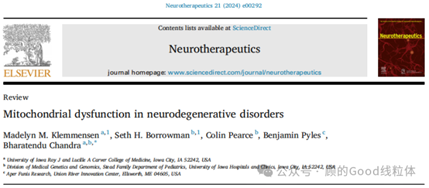
Figure 7: Relationship between neurodegenerative diseases and mitochondrial dysfunction
As a degenerative disease of the nervous system, Alzheimer's disease (AD)has a large number of patients and is extremely harmful to patients and their families. Therefore, biopharmaceutical companies have invested heavily in the research and development of new drugs for the treatment of AD. However, as of 2021, despite spending US$42.5 billion on AD treatment drug development, the failure rate is as high as 95%. Therefore, the prevention and treatment of Alzheimer's disease needs to be supported by new scientific discoveries and new theories.
Professor Chunjiu Zhong at Sun Yat-sen School of Medicine, Fudan University, independently proposed an innovative theoretical hypothesis of "brain energy (glucose) metabolism disorder" on the pathogenesis of AD, and found that pyruvate dehydrogenase and its coenzyme in the glucose oxidation pathway are dysfunctional.
Studies have found that patients with Alzheimer's disease will have cerebral glucose metabolism and absorption disorders 20 years before the onset of symptoms, which leads to the appearance of inflammatory spots in the brain and neuronal apoptosis, which in turn will aggravate the glucose metabolism and absorption of the brain, and they are mutually causal and eventually cause disease. At the same time, there is normal metabolism and absorption of ketones in the brain of these patients. Ketones are another source of energy for the brain besides glucose.
Mitochondrial lesions lead to AD, which is generally incurable, and could be treated to help reduce and alleviate symptoms. Palliative treatment of mitochondrial diseases, including: nutritional intervention, nutritional ketogenic therapy, calorie restriction, appropriate exercise, etc.
However, the clinical efficacy of nutritional interventions in the treatment of mitochondrial diseases such as neurodegenerative diseases, diabetes, and cardiovascular diseases did not meet the expectations of scientific studies (Fig. 8). The following three improvement measures are the clinical research and practice that need to be carried out in the future. This includes improving the formulation of the appropriate ratio of nutrients provided by nutritional intervention therapies (yeast cell extraction of total nutrients are the most preferred), how to get these nutrients to target cells, and metabolic programming (conversion of aerobic digestion to oxidative phosphorylation).
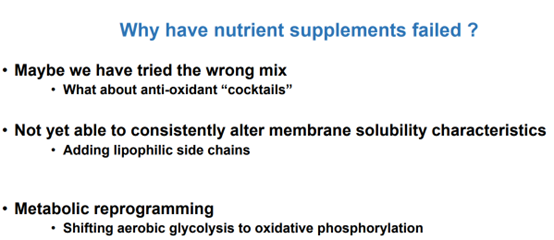
Figure 8: Reasons for poor efficacy of mitochondrial nutrition supplements (excerpt from: The role of nutrition care in mitochondrial health ASPEN nutrition
Science and Practice Conference Presented on March 20, 2021)
Yeast cells contain abundant mitochondrial nutritional factors, with high levels and appropriate ratios of various factors, which are easily absorbed and utilized by the human gastrointestinal tract. These nutritional factors come from yeast and have a second advantage, such as thiamine and riboflavin in their natural active forms, namely phosphate esters, which are heat-resistant and acid-base. They are not easily destroyed during cooking and storage, and can be efficiently absorbed and utilized. Taking thiamine (VB1), a nutrient that promotes mitochondrial structural integrity and normal function, as an example. VB1 has the highest content among all foods (Figure 9) and exists in a biologically active state (not easily destroyed, highly bioavailable).
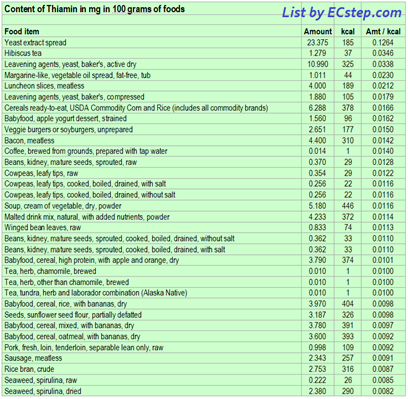
Figure 9: Thiamine content in various foods
In recent years, studies have found that supplementation with nutrients such as B-group vitamins can help reduce the risk of dementia. B-group vitamins include vitamins B1, B2, B6, B12, folic acid, and of course, vitamin D, w-3 fatty acids, etc. This large group of vitamins is mainly used as a coenzyme in the enzymatic reaction of mitochondrial oxidative phosphorylation, and participates in a variety of metabolic processes in the human body, which is of great significance for nervous system function.
A diet rich in antioxidant vitamins can improve a patient's cognitive function. As a result of adequate intake of B-group vitamins, homocysteine levels decrease, which indirectly prevents the development of the disease. An appropriately balanced diet and the use of appropriate supplements can help improve the clinical condition of AD patients.
2. Yeast Protein supports to build and implement nutritional ketogenic therapy for reversal of diabetes treatment.
In 2023, the number of reported diabetes patients in China reached 140 million, which reflects the dire situation of diabetes in China's public health sector.
Mitochondrial metabolism disorders in tissue cells of diabetic patients, especially pyruvate dehydrogenase dysfunction, are important components of the pathological mechanism of diabetes. This dysfunction manifests itself in several ways:
Prevalence of mitochondrial dysfunction: in patients with type II diabetes, hyperglycemia and insulin resistance lead to altered utilization of energy substrates in central and peripheral tissues, leading to mitochondrial dysfunction throughout organ systems. These dysfunctions include changes in mitochondrial morphology, dysbalance in kinetic homeostasis, and disruptions in quality control systems, which ultimately lead to impaired mitochondrial function.
There is no cure for mitochondrial diseases, and supportive treatment should be prioritized for symptom relief. In animal and cell models, ketone body combination supplementation rich in B-group vitamins and various mitochondrial nutrients (yeast protein is rich in various nutrients) can reduce oxidative stress, increase antioxidants, and eliminate free radicals. In addition, the ketogenic diet is well known.
Nutritional ketogenic therapy, where ketogenic action refers to the production of ketone bodies during the degradation of fatty acids. Under a ketogenic diet, ketone bodies are absorbed by monocarboxylic acid transporters, metabolized by mitochondrial enzymes into acetyl CoA, and directly enter the tricarboxylic acid cycle for complete oxidation. This indicates that ketogenic therapy can bypass the dysfunction of mitochondrial pyruvate dehydrogenase system in diabetes patients and directly use ketone bodies as energy sources.
Combined with caloric control, structured lipids rich in medium chain fatty acid triglycerides (ketone body raw materials), and yeast protein (rich in mitochondrial various coenzyme precursors and anti-reactive oxygen species), resistant starch application to build a set of safe, effective, less side effects, long-term adherence to the nutritional ketogenic diet therapy, applied to neurodegenerative diseases, cancer treatment fields, will achieve more positive results.
Ⅷ. Conclusion
Break through the technical bottlenecks such as the construction of yeast strains with high protein content and rich in human nutrients, low-cost, high-efficiency and environmentally-friendly sugar production of non-food biomass, high-efficiency and low-energy consumption of yeast disruption, and efficient recovery and preparation of yeast protein, so as to achieve the ultimate goal of industrialization and commercial operation of yeast protein.
The completion and industrialization of the sustainable alternative protein-yeast protein industry as a demonstration project for the development of new quality productive forces will greatly enhance the comprehensive self-sufficiency of meat protein in China and strategically ensure national food security.
Annotation: This article is the author's reflection on studying current affairs, connecting biotechnology with national food security strategies. Due to my limited theoretical level, limited ability to grasp professional and technical development trends, and limited writing skills, there must be some shortcomings. Please criticize and correct me.
This article does not list any relevant references. If readers have any needs, please let us know and supplement them.
Thank you for the “blog.sciencenet.cn” and Dr. Jin's consistent support and assistance.
转载本文请联系原作者获取授权,同时请注明本文来自徐斌科学网博客。
链接地址:https://wap.sciencenet.cn/blog-3569163-1454129.html?mobile=1
收藏


